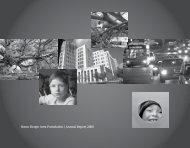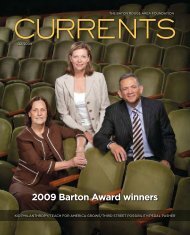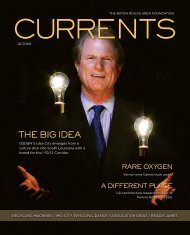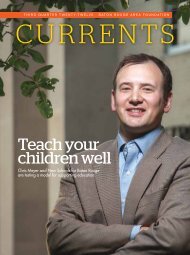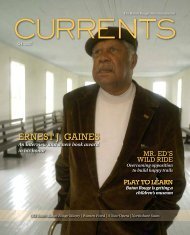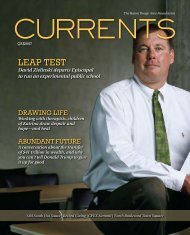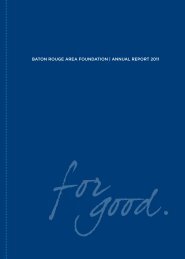The promise of Government Street - Baton Rouge Area Foundation
The promise of Government Street - Baton Rouge Area Foundation
The promise of Government Street - Baton Rouge Area Foundation
You also want an ePaper? Increase the reach of your titles
YUMPU automatically turns print PDFs into web optimized ePapers that Google loves.
c LETTER FROM THE CHAIR<br />
Conventional wisdom insists that <strong>Baton</strong> <strong>Rouge</strong> has<br />
sorted itself into four geographic areas. People in<br />
South <strong>Baton</strong> <strong>Rouge</strong>, it’s believed, don’t want the<br />
same things that residents <strong>of</strong> Shenandoah and Sherwood<br />
Forest seek. And certainly the inhabitants <strong>of</strong> Baker, Central<br />
and Zachary have very little interest in downtown and<br />
South <strong>Baton</strong> <strong>Rouge</strong>.<br />
At the <strong>Foundation</strong>, we wondered whether this was true.<br />
We wanted to know if East <strong>Baton</strong> <strong>Rouge</strong> is truly divided,<br />
and thus constrained. So, to find out what EBR really wants,<br />
we hired LSU’s Public Policy Research Lab. <strong>The</strong> Lab sought<br />
out a sample deep enough in the four geographic areas to<br />
discover where there might be agreement across those<br />
boundaries on current issues, such as a bond election, mass<br />
transit, and downtown development.<br />
<strong>The</strong> results that LSU delivered are surprising—and<br />
encouraging. <strong>The</strong> poll, which we believe is the largest survey<br />
<strong>of</strong> EBR ever conducted, revealed that respondents want<br />
better things for their parish and they are even willing to<br />
pay more in taxes for public projects—a remarkable finding,<br />
considering the nation’s current anti-tax mood.<br />
For instance, before the poll, anecdotal evidence<br />
suggested that residents were exasperated, even angry,<br />
about government spending to improve downtown over<br />
the last decade. But our survey shows that’s not really the<br />
case. Nearly half <strong>of</strong> those polled said the local government<br />
should spend more on downtown in the next decade, while<br />
another 20% said the amount should be about the same. In<br />
Southeast <strong>Baton</strong> <strong>Rouge</strong>, which includes Shenandoah, and<br />
the cities <strong>of</strong> Central, Baker and Zachary, a plurality said that<br />
government should spend more on downtown. Only 37%<br />
<strong>of</strong> respondents in Central/Baker/Zachary said spending on<br />
the city center should be cut.<br />
<strong>The</strong> results suggested some unsettling concerns as well,<br />
including evidence that EBR residents aren’t sufficiently<br />
attached to the community, with more than half saying they<br />
would not be unhappy to leave the parish. But, to us, what<br />
is most significant is the surprising degree <strong>of</strong> consensus<br />
on vital issues across the four geographic boundaries that,<br />
supposedly, divide us.<br />
<strong>The</strong> poll is part <strong>of</strong> our CityStats project, which measures<br />
the quality <strong>of</strong> life in EBR. It’s the first survey that doesn’t<br />
follow our pattern <strong>of</strong> annual reports, which are released in<br />
the spring. Our hope is that the survey will guide public<br />
policy, for it certainly presents a clear roadmap <strong>of</strong> what residents<br />
are willing to support.<br />
You can download the full report at BRAF.org under<br />
the reports section, or you can get a copy at Facebook.com/<br />
BRCityStats, where we continue a conversation about the<br />
future <strong>of</strong> cities. We thank the Newton B. Thomas Support<br />
<strong>Foundation</strong> for underwriting CityStats.<br />
• • •<br />
<strong>The</strong> idea <strong>of</strong> remaking <strong>Government</strong> <strong>Street</strong> into a vibrant<br />
thoroughfare has been discussed for more than a decade.<br />
Underpinning this dream are some hard economic advantages:<br />
turning a rough road into an appealing avenue will<br />
draw people to live on that street and around it, returning<br />
residents into the city center where infrastructure, paid for<br />
by taxes, already exists. What’s more, the resulting increase<br />
in property values provides a return on any public investment<br />
in reinventing the street.<br />
Years <strong>of</strong> talk about an improved <strong>Government</strong> <strong>Street</strong> may<br />
finally translate into true work-on-the-ground. Mayor Kip<br />
Holden and redevelopment groups have identified Mid City<br />
4 first quarter twenty-twelve<br />
c currents




